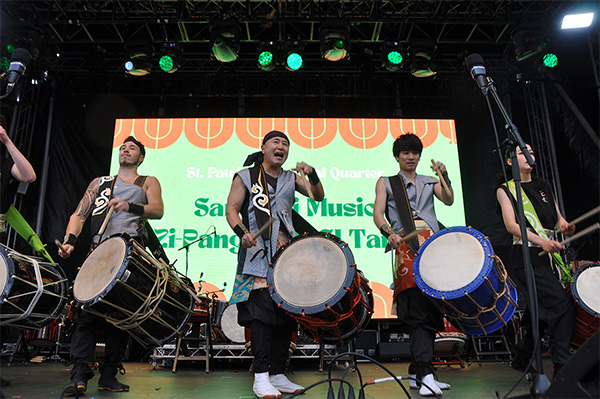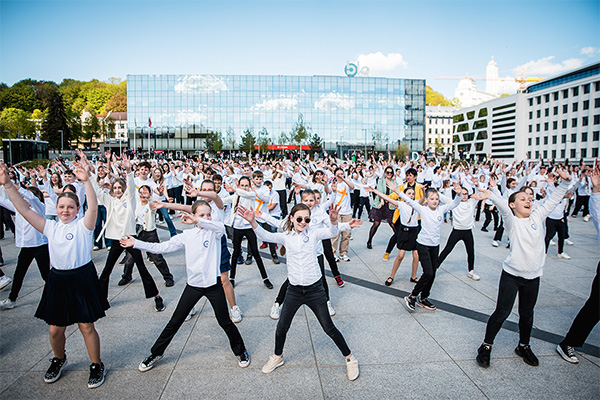Column
Columncontact Gonzo – KOSMOS Chemnitz
The project “Accident exercises” is a long-term collaboration between Rotterdam Presenta and the Japanese artist collective contact Gonzo. Originally developed in 2019, it was conceived as a site-specific performance designed to treat urban spaces not just as backdrops but as active co-performers. The core idea is to explore impact, collision, and fragility in public space, questioning how audiences perceive violence and risk when these elements are reframed artistically.
Since its creation, the piece has been adapted to a variety of unique locations—a former tram depot, an insurance archive, a multi-story car park—each time reshaping the choreography and dramaturgy to suit the new site. This approach is fundamental to the collaboration with contact Gonzo, who bring their very physical, improvisational practice from Japan to bear on each venue. Their willingness to experiment with raw, bodily confrontation has always inspired us to rethink what a “safe” performance space can be.
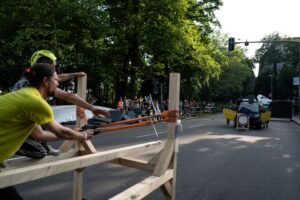
For the KOSMOS Festival in Chemnitz, European Capital of Culture 2025, the chosen venue was a busy street used as a main transit route during the festival. This offered an ideal scenario: the street itself, full of movement and potential collisions, mirrored the piece’s themes. It was a site that couldn’t be neutral—it was already loaded with meaning as a place of crossing, connection, and potential conflict.
This choice also brought real challenges. In earlier iterations we had strict audience guidance and clear boundaries for viewing, ensuring safety while controlling perspective. In Chemnitz, the audience was largely “walking,” free to enter and leave at will, which meant we needed to reimagine how to hold their attention without imposing formal barriers. The result was unexpectedly rewarding. Despite the open setting, we found ways to focus the audience’s gaze, especially during climactic moments.
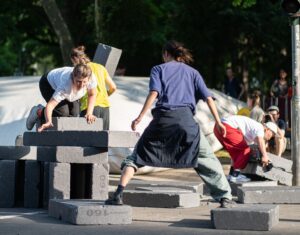
One adaptation to the venue was the use of its sheer scale. We were able to incorporate long-distance movement and a large surprise element by hiding the car at first, then revealing it as both prop and participant. The car didn’t just appear—it brought along other items like a catapult and served as a target, finally being driven around the space itself. This flexibility was typical of our approach with contact Gonzo: they treat objects and environments as collaborators rather than inert scenery, and this philosophy has deeply influenced our process.
A particularly memorable aspect was the new integration of an airbag. The performance began gently with polystyrene structures slowly collapsing across the street—an ambiguous, almost ignored action. This changed dramatically when the performers inflated the giant airbag onto which they jumped repeatedly. It was a shock, drawing immediate attention and recalibrating the audience’s focus. This newly developed element worked perfectly to punctuate the more subtle sequences and to shift the mood from quiet unease to explosive spectacle.
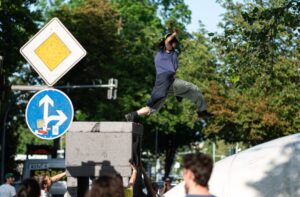
The audience reaction was striking. Many people chose to sit along the side of the street, forming informal grandstands, eagerly awaiting the next collision. Each impact produced cheers, laughter, and surprised exclamations. Yet there was also a palpable tension—they were observers of danger without being part of it. We heard afterwards in discussions with individual spectators that this safe distance forced them to confront the contradictions of watching violence as entertainment, and the fragility of the human body versus the car body. Some described it as unsettling but fascinating, precisely the response we were hoping for.
Collaborating with contact Gonzo again was central to this success. Their approach to physical performance is rooted in Japanese street culture, improvisation, and an unflinching honesty about violence and risk. Working with them challenges us to avoid theatrical artifice and to embrace real danger (carefully mediated for safety). This partnership is a true dialogue between cultures, not just in style but in underlying questions about social order, rules, and what we can show in public space. It is always confrontational in the best sense.
Beyond the performance itself, the festival context offered a rich framework for exchange. We had the chance to meet other artists, local organisers, and even city politicians who came to watch. It was rewarding to see that this kind of risky, challenging work could be hosted as part of an official Cultural Capital programme. It proved to us that such performances don’t need to be marginal—they can be central to discussions about what public culture can be.
We were also grateful for the opportunity to revive and develop accident exercises thanks to support from EU-Japan Fest Japan Committee, the City of Düsseldorf, and the City of Chemnitz. It allowed us to premiere this version in Düsseldorf, where the large Japanese community provided an especially meaningful audience. The positive feedback in both cities confirmed for us that this piece still resonates, and that the collaboration between Rotterdam Presenta and contact Gonzo remains vital.
Looking ahead, we see great potential for this work to travel further. Its site-specific nature means it can adapt endlessly, always posing new questions in new contexts. We are already discussing future performances with contact Gonzo in other European and Japanese cities. Our hope is that accident exercises can continue to be a platform for cultural exchange, pushing audiences—and ourselves—to rethink what collision, impact, and shared public space really mean.




